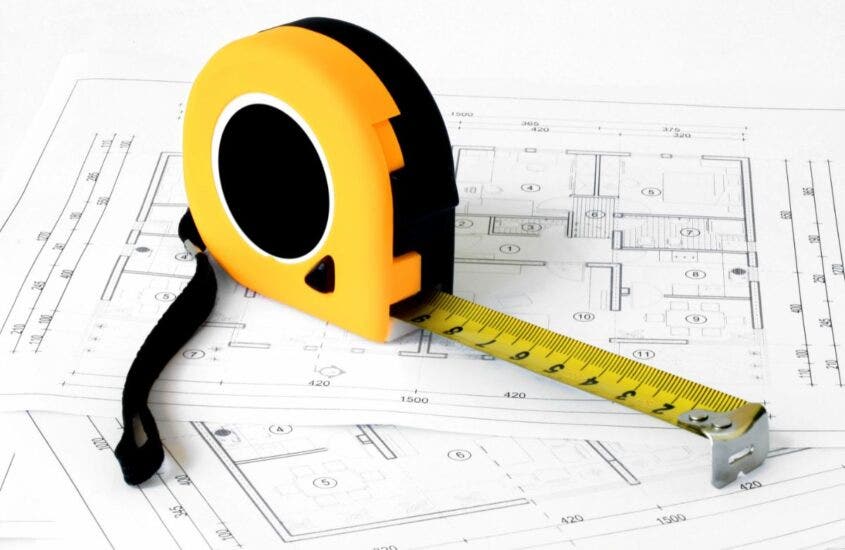How To Read A Measuring Tape

One of the most popular tools out there is a measuring tape, whether it’s for trying to determine if a piece of furniture or kitchen appliance is going to fit into a certain space, or if you’re just trying to find the dimensions of a room, the uses for a measuring tape are endless.
They can be found nearly everywhere too, and you can be sure that every contractor you meet will have one handy should they need to use it.
But for those who use them every day, reading and using a measuring tape is a well honed skill.
But for the amateurs among us, reading a measuring tape can be quite difficult, especially if you’ve never read one before.
So, if you’ve never used a measuring tape before, or you’re just a little unsure on how to read it properly, then don’t worry, as we’ve created this guide to help you learn how to read a measuring tape!
Table of Contents
What The Lines Mean
When it comes to reading a tape measure, there are a lot of things to take in at first, but it’s best to start off simple, and that’s to look at the big lines that are on the tape measure.
On a tape measure with imperial units, these big lines represent one inch, and you’ll be able to tell these apart from the other lines as they’ll be longer, thinner, and marked with larger numbers on top of them.
Sometimes, after every 12 inches, there will be a marking to represent a foot, although there won’t always be, so you should keep a mental note that 12 inches are equal to a foot.
Sometimes after a foot marketing, the numbers will either continue counting upwards or will revert back to 1, this entirely depends on the tape measure.
It’s also worth noting that when measuring an inch, the long thin line is what represents an inch, not the big number next to it.
This is often what causes a lot of confusion amongst first-time users, and can lead to things being measured incorrectly!
In between, each inch marking will be a slightly smaller line that is still bigger than most, and this is the ½-inch line.
From ½ and below, there is a chance that the markings won’t have any numbers on for you to count them, so it’s important that you learn the ½-inch and inch line markings well to be able to determine the length of things properly!
There is also one more marking to know about, and that is between each ½-inch marking will be another line that is ever so slightly longer than the rest, this is a ¼-inch line, and there will be four of them per every inch.
You may be wondering then, “what do the other lines represent?”, and the answer is that they represent 1/16 of an inch, there will be 16 of these lines for every inch on the tape measure, and four per quarter.
Most measuring tapes won’t have any lines smaller than this unless you happen to have an extremely precise measuring tape, which might have lines to show 1/32 of an inch!
Measuring Using A Measuring Tape
When it comes to using a measuring tape, you’ll first need to mark where the measuring tape is able to line up on the edge of whatever you’re measuring, you then need to find the closest inch to this point.
Then move it to the nearest half inch, then the closest quarter inch, and so on.
You will then need to add up all of the inches as well as the fractions of the inches in order to find the most accurate measurement, this can be difficult, so let us give you an example:
So, let’s say you’ve measured something that is beyond the one inch mark, past the one quarter inch mark, and also past the one eighth of an inch mark.
In order to then work out what the measurement would be, all you need to do is add together the 1 inch + ¼ inch + ⅛ inch.
To make it a little easier, because there are two-eighths of an inch in a ¼ inch, you can instead write it as 1 + 2/8 + ⅛ = 1 ⅜ inch.
General Advice
If you’re measuring something like a wall, or something with a flat surface, most measuring tapes will have a handy little metal hook on the end, which will allow you to latch it onto a corner of a surface to help make measuring that particular length much easier!
Just don’t forget to take into account the length of this metal hook when it comes to measuring your lengths if you’re not using it to latch onto a surface.
Where should I start to read a tape measure?
Pull out the tape until you reach the opposite end of the item or space you want to measure, then place the end tab at one end. Once you have taken a measurement reading, you can add the increments together to determine the length. For example, if your item is exactly 3 inches or 3 feet long, it’s easier to do.
Do you start at 0 or 1 on measuring tape?
To measure on a measuring tape, place the object or first measuring point so the “0” is at one of the ends, and then measure to the other object or line and note the black line on the measuring tape that it lines up with and the measurement that is associated with that line.
Safety Tips
Overall, there aren’t many safety concerns you should be aware of when it comes to using a measuring tape, as they’re typically pretty safe pieces of equipment, especially in comparison to things such as hammers or wrenches.
However, one thing you should keep in mind is that tape measures are spring-loaded and wind themselves up automatically.
And although to many this is an incredibly useful feature, it can also be extremely dangerous considering how fast they wind back up.
As a result of this, you should always wear some form of protective eyewear when using a tape measure, as incidents, where people have had their eyes caught by a returning tape measure hook, aren’t as uncommon as you think.
Conclusion: How To Read A Measuring Tape
Overall, reading a measuring tape is an easy task once you are used to doing it, and all it takes is a little practice!







Comments are closed.